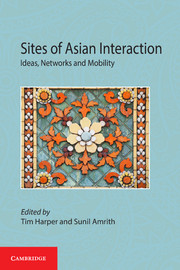Book contents
- Frontmatter
- Contents
- List of figures
- Preface
- Introduction
- 1 Singapore, 1915, and the Birth of the Asian Underground
- 2 Living in the Material World: Cosmopolitanism and Trade in Early Twentieth Century Ladakh
- 3 Nation, Race, and Language: Discussing Transnational Identities in Colonial Singapore, circa 1930
- 4 Intimate Interactions: Eurasian Family Histories in Colonial Penang
- 5 Citing as a Site: Translation and Circulation in Muslim South and Southeast Asia
- 6 Popular Sites of Prayer, Transoceanic Migration, and Cultural Diversity: Exploring the significance of keramat in Southeast Asia
- 7 Connecting People: A Central Asian Sufi network in turn-of-the-century Istanbul
- 8 ‘Enough of the Great Napoleons!’ Raja Mahendra Pratap's Pan-Asian Projects (1929–1939)
- 9 Chinatowns and Borderlands: Inter-Asian Encounters in the Diaspora
- 10 Creating Spaces for Asian Interaction through the Anti-Globalisation Campaigns in the Region
- Contributors
- Index
6 - Popular Sites of Prayer, Transoceanic Migration, and Cultural Diversity: Exploring the significance of keramat in Southeast Asia
Published online by Cambridge University Press: 05 July 2014
- Frontmatter
- Contents
- List of figures
- Preface
- Introduction
- 1 Singapore, 1915, and the Birth of the Asian Underground
- 2 Living in the Material World: Cosmopolitanism and Trade in Early Twentieth Century Ladakh
- 3 Nation, Race, and Language: Discussing Transnational Identities in Colonial Singapore, circa 1930
- 4 Intimate Interactions: Eurasian Family Histories in Colonial Penang
- 5 Citing as a Site: Translation and Circulation in Muslim South and Southeast Asia
- 6 Popular Sites of Prayer, Transoceanic Migration, and Cultural Diversity: Exploring the significance of keramat in Southeast Asia
- 7 Connecting People: A Central Asian Sufi network in turn-of-the-century Istanbul
- 8 ‘Enough of the Great Napoleons!’ Raja Mahendra Pratap's Pan-Asian Projects (1929–1939)
- 9 Chinatowns and Borderlands: Inter-Asian Encounters in the Diaspora
- 10 Creating Spaces for Asian Interaction through the Anti-Globalisation Campaigns in the Region
- Contributors
- Index
Summary
Introduction
This chapter explores keramat, or the venerated graves of notable figures, as a location of socially and culturally diverse practices in the history of Muslim Southeast Asia (also referred to as the ‘Malay world’ here). While these sites comprise the graves of people of a variety of ethnic backgrounds, histories, and faiths, they are usually associated with Muslims, and frequently with Hadramis. In the course of studying Hadrami migrations to Java, I was struck by the observations of keramat made by the colonial scholar-bureaucrats C. Snouck Hurgronje and L. W. C. van den Berg. Both men noted the high stature of the keramat of a Hadrami scholar in Luar Batang, Batavia (present-day Jakarta, Indonesia), as well as the multi-ethnic following it had in the late nineteenth century. In this chapter, I revisit keramat with the hope of gaining further insight into the dynamics of cultural and social diversity in the modern history of Muslim Southeast Asia.
This chapter draws together two areas of interest to me. The first is the significance of ubiquitous popular shrines—often intimately tied to the land—to the contemporary societies of Indonesia, Malaysia, and Singapore. The second is the study of Hadramis and Islam in Southeast Asia. The latter is a long-standing area of research for me and hence a subject that I approach with some surefootedness. The former is a more recent interest about which my knowledge is still at a formative stage.
- Type
- Chapter
- Information
- Sites of Asian InteractionIdeas, Networks and Mobility, pp. 127 - 143Publisher: Cambridge University PressPrint publication year: 2014
- 1
- Cited by

